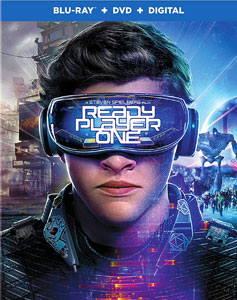Director Steven Spielberg’s adaptation of “Ready Player One” – now available for home viewing — captures the spectacle and banter of Ernest Cline’s novel without fully tapping into the serious stakes nor the veneer of dystopian sadness. The 2-hour, 20-minute epic has the type of momentum a gamer could relate to after realizing the hours have just melted away as his quest went along. And the action is scored by classic arena rock. But what’s fun in any given moment adds up to something less substantial than it should be, even if there are a lot of cool moments.
This is odd because Cline’s book – and even the script he co-wrote with Zak Penn – acknowledges the sadness of the society that’s coming right around the corner: lives lived mostly in a virtual realm, with breaks only for eating, sleeping and using the bathroom. But it’s only given lip service on screen. The film should’ve leaned more into what humanity gains and loses from this sea change in technology.
The stakes for this downtrodden 2045 rest on whether good guy Wade/Parzival (Tye Sheridan) or Innovative Online Industries’ villain Sorrento (a nicely understated Ben Mendelsohn) wins the grand virtual game. The prize is winner-take-all: control of the Oasis. We know how bad it will be if IOI runs this virtual world; indeed, the corporation already runs “loyalty centers” of indentured servitude.
If Wade wins … well, at least he’s not evil; he’s a Spielberg hero, after all. Maybe Wade’s sense of why the 1980s were great runs deeper than his appreciation for the movies and video games loved by Oasis creator James Halliday (Mark Rylance, effective as a pained introvert). But Wade is largely like Giles from the “Buffy” episode “The Wish.” If you were to ask him why a world not ruled by IOI would be better, he’d say “Because it has to be.”
Wade soon meets Samantha/Art3mis (Olivia Cooke), who is immediately his love interest in that classic guy’s-film fashion where the female lead exists to be a love interest, and where we never know where she is coming from. We don’t get an old-fashioned drama where Wade has to win her over; the suspense comes simply from the fact that we don’t see Sam’s point of view. (Spoiler alert: She likes him back.) Sam has more to do in the final act here than she does in the book, but that awkwardly causes the focus to shift from the central hero to this girl who had resisted character definition.
The so-called High Five is rounded out by Wade’s longtime best friend Aech (whom he hasn’t met outside the Oasis) and Japanese brothers Sho and Daito. It might’ve been neat to see these friends being shy when they first meet in reality, as a contrast to their gaming banter. But human interaction in 2045 is not a lost art; it has simply moved into the Oasis. That raises an interesting question: Is that such a bad – or sad – thing after all?

It’s hard to argue against it when we see how the Oasis allows a player to live inside of pop culture. People are constantly entertained in the Oasis. Without delving into the pop-culture references – which are supposed to be delightful surprises – I’ll note that our heroes’ journey is often backed by 1980s arena rock: Van Halen’s “Jump,” for example. We’ve already seen the “Guardians of the Galaxy” films mix outer space with vintage tunes. It’s fun in those movies because Star-Lord’s nostalgia is for Earth. It’s a bit sad in “Ready Player One” because Wade’s nostalgia is for one generation prior when the economy and standard of living was good.
Spielberg does an excellent job of showing how the haptic suits, gloves and goggles work amid the action, rather than clunkily telling us a la the infamous “dino DNA” segment of “Jurassic Park.” In one clever segment, Wade is fighting in the virtual reality and simultaneously fighting off a real-world attacker from IOI. Usually, a haptic-suit-clad person appears to be flailing at thin air in the real world, but here the situation is reversed.
For all the fun, though, there’s something phony about “Ready Player One,” and not totally because it mostly takes place in a false reality.
(SPOILERS FOLLOW.)
The references are fun, but oddly limited. The quest takes the High Five to the Overlook Hotel from “The Shining,” Aech uses the Iron Giant as an avatar to fight Mechagodzilla, and Wade drives around in the “Back to the Future” DeLorean. It’s not totally immersive: There’s a sense of “Oh, the filmmakers got the rights to use that thing.” The only limitation of Cline’s book was his imagination, since describing something with words does not trigger copyright laws.
But the big problem is the plot. Maybe “Ready Player One” is one of those films where plot is unimportant beyond serving structural needs – similar to a video game where we say “Just go with it! It’s fun!” Even by that standard, the laziness of this film’s game-style plot has to be mentioned.
Halliday’s game includes infinite pieces of information that could be clues, and infinite solutions even if someone guesses what piece of information is a clue. Our heroes always solve them, because that’s what the screenplay needs to happen – and this is the biggest reason I wasn’t totally drawn into the movie.
For example, Wade visits the Halliday history museum and watches a video of Halliday telling Oasis co-founder and friend Ogden Morrow (Simon Pegg) that he wishes he could go back in time. Wade guesses this is a clue, and then guesses the solution is that he should drive backward at the game’s starting line while everyone else goes forward.
Cline used this guess-a-clue/guess-a-solution structure in his book, but in literary form, there is more of a sense that the game might be infinite – that it might even be purposely unsolvable because Halliday was nuts. So it works, if barely.
In the movie, for the sake of a mainstream audience, the clues and solutions can’t be as centered on insider gaming history, but Penn and Cline miss an opportunity to use more pop-culture based clues/solutions that could’ve been a lot of fun for the audience. Copyright hang-ups or reticence to use Spielbergian references (which might’ve seemed self-serving) might’ve been factors. But that doesn’t justify the absurdity of Wade noticing that Halliday once said he wished he could go back in time and correctly guessing he must drive his car backward.
“Ready Player One” is about Wade, Sam and friends taking control of the game, and their own destinies. That’s undermined when they’re at the mercy of where the script takes them.

